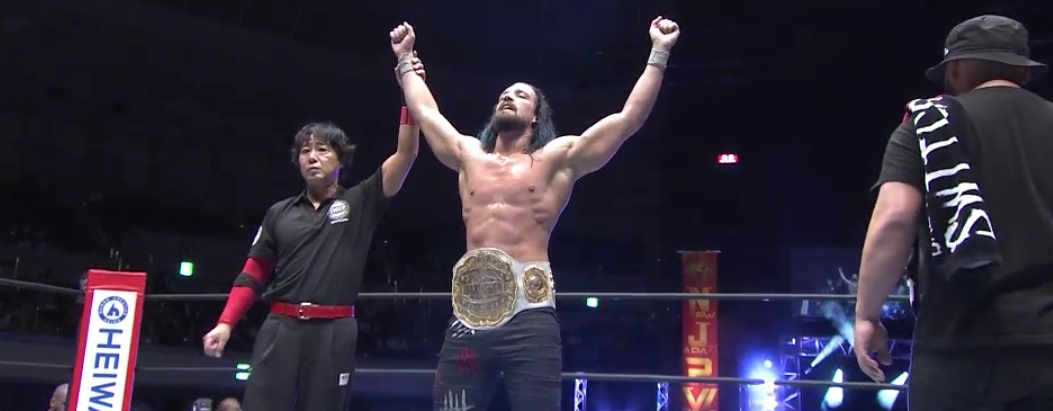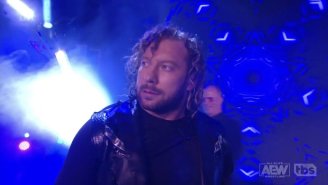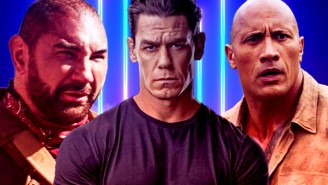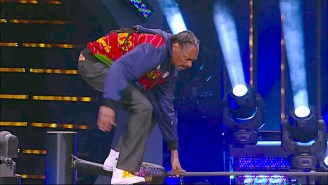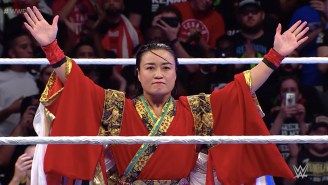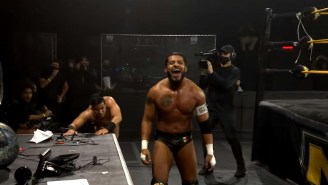Previously on NJPW: Ibushi kept his contract, Tanahashi lost his title, and the dojo boys continued to their long fight for a trophy that says “VICTORY” on it.
You can watch New Japan Pro Wrestling shows on their streaming service, NJPW World, which costs 999 yen (about 9 USD) per month. You can also watch certain NJPW matches on Saturdays on AXS TV.
You can keep up with With Spandex on Twitter and Facebook, follow our home site Uproxx on Twitter, and even follow me on Twitter @emilyofpratt. Don’t forget to share this column on Facebook, Twitter, or whatever social media you use! Also, leave a comment with your thoughts on the show and/or article! All feedback is appreciated and will help us keep up the NJPW coverage.
And now, the best and worst of Destruction in Kobe, which took place at Kobe World Memorial Hall on September 22, 2019.
Best: Party For The West Coast
[Replay ‘DESTRUCTION in KOBE’ on September 22nd, 2019]
3RD MATCH: 12th Young Lion Cup League Match @njpw_shota vs. @Karl_Fredericks!!
Watch on New Japan World▶︎https://t.co/Tj7UBJ4PjP#njpw #njpwworld #njdest pic.twitter.com/7R6iLLPpK6— NJPW WORLD (@njpwworld) September 22, 2019
Destruction in Kobe opens with back-to-back-to-back Young Lion action. After a decent multi-man opener , there is, in classic New Japan round-robin fashion, a situation where if one person (Ren Narita) wins the second-to-last match he could win the whole thing by tiebreaker (over Karl Fredericks.) They don’t make things that complicated though, and Clark Connors defeats Narita in a solid match that’s all about showing those strong dojo fundamentals.
Our final match of the tournament is Shota Umino vs. Karl Fredericks and it’s as good a showing as we’ve come to expect from these guys. Fredericks shows impressive athleticism with that smooth leapfrog right into a crossbody and Umino’s work with the cross arm breaker creates some engaging drama. Then it ends with Fredericks tapping out Umino with his now-signature single leg Boston Crab (plus some head-stomping) and the crowd goes silent.
This is a pretty shocking result not because of how the match was wrestled or Fredericks’ tournament performance, but because we hardly know the guy. The only people I know who were happy that Fredericks won were people who know him personally. How could anyone else have a stronger emotional connection to him than Umino at this point? Fredericks’ win put over the LA Dojo as legit and Fredericks as a wrestler to watch, but the way it sucked the air out of the arena was completely understandable. I don’t think this is what most people expected or wanted from this tournament.
For the most part, I think the backstage fallout of the tournament is very well done. Narita says “I’ve made up my mind” after his loss and appears later to bow to special guest star Katsuyori Shibata and ask to join the LA Dojo. The scene between Narita and Shibata, who continues to crush it as a non-wrestling character, might put over the LA Dojo more effectively than Fredericks’ promo, which sounds pretty inorganic, like a student athlete’s Instagram caption that also includes Big Sean lyrics. This might be the biggest issue with the LA Dojo boys at this point; they seem like such borderline-uptight good students that they don’t have memorable wrestling personas yet.
In contrast, Umino is a recognizable character and very passionate as he vows to start over from the bottom and someday pay back Fredericks for this loss he hates the most of all his many losses. Though Umino and Narita, the most established characters in the Young Lion Cup, didn’t win the thing, it sends them off on their excursions in a way that keeps people invested in their journey, wanting them to do well and wishing them the best when they come back and re-debut as people who get to win more.
Best: WELCOME TO HELL
[Replay ‘DESTRUCTION in KOBE’ on September 22nd, 2019]
5TH MATCH: @azucarRoc , Tiger Mask , @Liger_NJPW & @tanahashi1_100 vs. @DoukiPerros , @kmaru0923 , @suzuki_D_minoru & @zacksabrejr!!
Watch on New Japan World▶︎https://t.co/Tj7UBJ4PjP#njpw #njpwworld #njdest pic.twitter.com/imiK99lYxq— NJPW WORLD (@njpwworld) September 22, 2019
On the opposite end of wrestlers’ career journeys, the feud between Minoru Suzuki and Jushin Thunder Liger takes its best turn yet. Liger jumping Suzuki from behind during his entrance shoots adrenaline into the show. The “match” only escalates from there because it turns out Liger decided to respond to Suzuki’s promo about wanting “the real you” by voluntarily unleashing KISHIN LIGER, who’s previously only come out when someone else has removed the mask.
[Replay ‘DESTRUCTION in KOBE’ on September 22nd, 2019]
5TH MATCH: @azucarRoc , Tiger Mask , @Liger_NJPW & @tanahashi1_100 vs. @DoukiPerros , @kmaru0923 , @suzuki_D_minoru & @zacksabrejr!!
Watch on New Japan World▶︎https://t.co/Tj7UBINesh#njpw #njpwworld #njdest pic.twitter.com/xvhGunCtgV— NJPW WORLD (@njpwworld) September 22, 2019
Liger tries to stab Suzuki with a spike and it’s absolutely insane. And Liger’s performance as his demon self is next-level amazing, especially the way he emerges from his bodysuit like it’s a cocoon. Suzuki revealing backstage that he absolutely loves this and is so happy he got what he asked for is great as well. These two continue to remind everyone that they didn’t get their legendary reputations by accident every time they work together.
And if you’ve never gotten around to watching the Liger vs. Great Muta match that contains the first (of four) appearances by Kishin Liger, now is the time, because they’ll finally be working that much-anticipated singles match together at King of Pro Wrestling! Someone may die!
Worst: Most Of The Multi-Mans
[Replay ‘DESTRUCTION in KOBE’ on September 22nd, 2019]
4TH MATCH: @HenareNZ , Tomoaki Honma & @GBH_makabe vs. @realchaseowens , Yujiro Takahashi & @TOKSFALE!!
Watch on New Japan World▶︎https://t.co/Tj7UBJ4PjP#njpw #njpwworld #njdest pic.twitter.com/oSKettCNlH— NJPW WORLD (@njpwworld) September 22, 2019
With a lot of big NJPW shows it’s easy to say the highlights are the singles matches and the less memorable things are the tag matches that are really about future singles matches. However, those multi-man tags often feel a lot more important in themselves than the ones on Destruction in Kobe and are more entertaining. The weakest of the bunch is the Bullet Club vs. Not GBH trios match that’s clearly just a pee break/cool down from the Young Lion Cup. (It’s also a reminder that if Toa Henare had gone to WWE like he had a chance to do before entering the New Japan dojo he could easily be on the USA Network or at least NXT UK right now actually doing things instead of doing basically nothing of note since graduating the dojo over a year ago.)
We also get a Chaos vs. Bullet Club ten-man tag and a Miscellaneous Good Guys vs. L.I.J. six-man tag that turn out to all be building towards either the upcoming Fighting Spirit Unleashed tour in the U.S. or King of Pro Wrestling, which is now jam-packed with singles matches. The wrestling is fine, with nothing new added to any of with the rivalries except that Kenta vs. Yoshi-Hashi for the NEVER Openweight Championship is a thing now. Yoh gets another roll-up pin on G.O.D. to solidify Roppongi 3K’s claim to the tag titles (they’ll get their match on one of the American shows that won’t air live), but it’s not exciting as the one in Kagoshima. ELP and Ospreay have a sad brawl and backstage, ELP continues his streak of talking about his matches like they’re about star ratings rather than winning.
Both of the matches previewed by the six-man tag – Sanada vs. Okada and Evil vs. Ibushi – seem to have inevitable results. At least, though, in addition to the chance these matches in themselves will be good (especially Evil and Ibushi, who go extra hard here), there’s some interest built by the fact that they’re both happening at KOPW. Most of the stuff one can normally expect to happen before Wrestle Kingdom is getting wrapped up in mid-October, leaving lots of time for possible twists and for the double title situation to be worked out. Elements of New Japan’s autumns had started to feel more like stagnation than tradition and it seems like this double championship thing could help with that, just like all the new blood helped this year’s G1.
Best: Last Samurai Standing
Even before it begins, there are a lot of positive things to say about Hirooki Goto vs. Shingo Takagi. One can engage with it really easily on the level of wanting to see these two go hard and beat each other up. It can be a handsome battle too, if that’s your thing. But there’s also a clear sense, as commentary outlines before the match, of what this match means for both of these men at this point in their careers in addition to them wanting to beat each other up.
Coming off his hot streak at the end of the G1, it’s extra important for Takagi to win his first official match as a heavyweight. He’s so sure that he can use Goto as a stepping stone to a title shot that he’s gotten cocky and started doing Goto’s moves. Meanwhile, Goto is coming off of a G1 that started with him defeating a man who humiliated him earlier in the year and ended with him losing to his alternate universe self. Despite the LA excursion, he still seems like a guy who could plausibly get beaten with his own move as a stepping stone for another guy, and he obviously doesn’t want to be that, especially after he went and trained all the way in another country to turn his career around.
[Replay ‘DESTRUCTION in KOBE’ on September 22nd, 2019]
8TH MATCH: SPECIAL SINGLES MATCH @510njpw vs. @Takagi__Shingo!!
Watch on New Japan World▶︎https://t.co/Tj7UBINesh#njpw #njpwworld #njdest pic.twitter.com/QfMA6j9wHS— NJPW WORLD (@njpwworld) September 22, 2019
There are some details in the match that pay off this storyline (Takagi makes most of his attempts at Goto’s signature moves right at the beginning and Goto evades them), but for the most part, this is two tough wrestlers having a fight and it’s really fun to watch. They make this thing exciting, competitive, and hard-hitting. As in their first match, it’s immediately clear that these two complement each other in the ring. And though Takagi’s still below Goto in the NJPW pecking order, him wrestling as cocky as he sounded in his promos, much closer to his jerkass Dragon Gate heel character when wrestling in the home of DG’s biggest show of the year, sets up Goto as the more sympathetic character when he wins.
Both guys have solid backstage segments too, especially Goto, who always comes off well when he gets to be less uptight. Takagi’s reaction to his loss is similar to after the BOSJ final, resolving immediately to get back in the game, but this time there’s no clear next move for him to make. This is the first time he’s completely lost momentum and hasn’t had a clear direction since he came to New Japan almost a year ago. That singles match with Henare on October 7 signals that there must be plans for him in the near future, but for now, for the first time, he’s in the nebulous non-title NJPW wrestler zone to which everyone outside of the big four is usually relegated for months out the year. R.I.P. to that eleven-month increasingly hot streak; maybe another one will start soon.
Smiles For Miles
[Replay ‘DESTRUCTION in KOBE’ on September 22nd, 2019]
9TH MATCH: IWGP INTERCONTINENTAL CHAMPIONSHIP MATCH @s_d_naito vs. @JayWhiteNZ!!
Watch on New Japan World▶︎https://t.co/Tj7UBINesh#njpw #njpwworld #njdest pic.twitter.com/ZIM6jiyiVX— NJPW WORLD (@njpwworld) September 23, 2019
The main event of Destruction in Kobe is a thirty-minute match in which Jay White defeats Tetsuya Naito to become the Intercontinental Champion. It’s an effective match, with the crowd the most invested towards the end despite the long runtime. I think both men have had multiple better matches in 2019, but Naito pretending to be distracted by Gedo, then taking out both he and White with a DDT is one of Naito’s best moments of the year. White’s L.I.J.-style Bullet Club roll call is up there for him too. Overall, though, I think this is one of the many long matches that NJPW does now that have all the pieces of A Good Match but soon fade into all the long Good Matches that happen every year.
After commentary gleefully informs us that sad Naito fans are leaving the building (New Japan did it, you guys, they have a Real Heel on their hands!) and White does the aforementioned good roll call bit that lightens the mood, Hirooki Goto comes out looking all business and pops him in the face. It’s not as exciting as when Goto surprise-returned from LA to do a similar thing months ago, but he looks good. The crowd seems more polite about it than anything.
White insists backstage that Goto shouldn’t get a title shot against him because he holds a winning record over Goto, as if New Japan is trying to do the same type of win/loss record thing that AEW is right now or something. But this is New Japan, so as long as you win a singles match and step up to a titleholder (rather than win a singles match and then start shit with someone else), then you get a title shot! Win-loss records don’t matter outside of tournaments! Maybe New Japan wrestlers should not bring up stuff like “winning records” because it makes the New Japan title shot system look less credible!
So now it can be assumed that Jay White vs. Hirooki Goto is happening again, this time for the IC title, and I don’t know, maybe it will be good. Almost everything happening in New Japan right now besides Liger vs. Suzuki feels meaningless beyond the possibility it could produce a good match in itself. That should probably change after or around King of Pro Wrestling when we find out what’s happening with this double title situation (and honestly, the fact that Naito’s looking more jacked than usual gives me more hope that he could still be part of that more than anything about how bleak it would be for the guy who started this whole race to become the first double champ not becoming the first double champ), but right now it’s like, hey, matches are happening in New Japan! Watch them if you want!
To end the article on a less jaded note, the next live broadcast NJPW show is the New York installment of the Fighting Spirit Unleashed tour on September 28 and it includes a six-man tag match of the Rock ‘N’ Roll Express and Tanahashi vs. Naito, Shingo, and Bushi. That rules. That’s a really fun idea. I’ll be back here next week to talk about the show with that on it.

